-
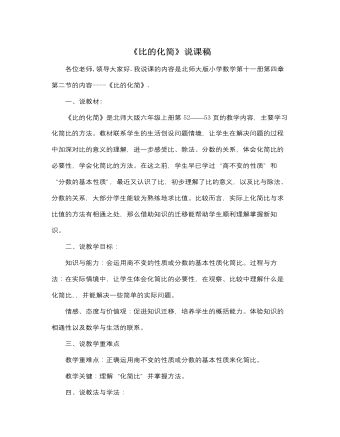
北师大版小学数学六年级上册《比的化简》说课稿
《比的化简》是北师大版六年级上册第52——53页的教学内容,主要学习化简比的方法。教材联系学生的生活创设问题情境,让学生在解决问题的过程中加深对比的意义的理解,进一步感受比、除法、分数的关系,体会化简比的必要性,学会化简比的方法。在这之前,学生早已学过“商不变的性质”和“分数的基本性质”,最近又认识了比,初步理解了比的意义,以及比与除法、分数的关系,大部分学生能较为熟练地求比值。比较而言,实际上化简比与求比值的方法有相通之处,那么借助知识的迁移能帮助学生顺利理解掌握新知识。二、说教学目标:知识与能力:会运用商不变的性质或分数的基本性质化简比。过程与方法:在实际情境中,让学生体会化简比的必要性,在观察、比较中理解什么是化简比,,并能解决一些简单的实际问题。情感、态度与价值观:促进知识迁移,培养学生的概括能力。体验知识的相通性以及数学与生活的联系。
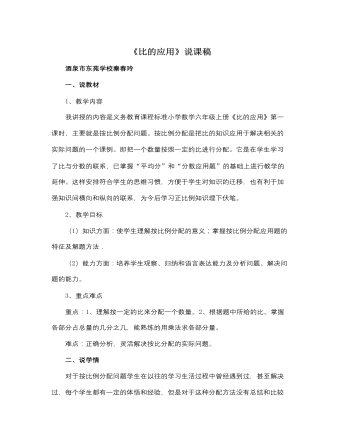
北师大版小学数学六年级上册《比的应用》说课稿
接下来引导学生分析题中数量关系:题目要分配什么?按照什么分配?重点思考讨论:从3:2这个比中,你能知道什么?接下来鼓励小组合作尝试多种方法解答,重点理解按比分配的方法。2、小结:按比分配的应用题有什么结构特点?怎样解答这样的应用题?这样设计为学生提供自主探索的空间。所以在教学中可以灵活地依据提出的方法调换教学顺序,并引导学生掌握两种不同的解题方法。安排学生的小组讨论方式能使学生一开始就畅所欲言,把几种不同思路比较和联系起来,在理解的基础上才能更好的掌握方法,并注意培养学生的检验能力。第三个环节:多层训练,形成技能。练习是数学课堂教学一个重要环节,我设计的练习题力求做到从易到难,由浅入深,有层次,有坡度,新旧知识融合恰当,形成技能技巧,开拓思维,发展能力,达到练习的预期目的。
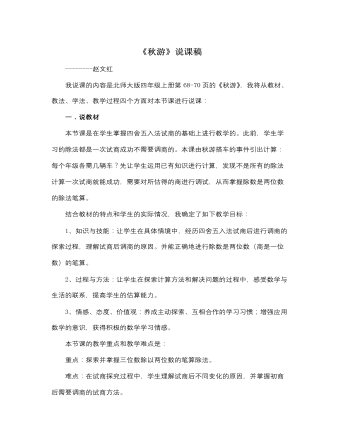
北师大版小学数学四年级上册《秋游》说课稿
我说课的内容是北师大版四年级上册第68-70页的《秋游》,我将从教材、教法、学法、教学过程四个方面对本节课进行说课:一.说教材本节课是在学生掌握四舍五入法试商的基础上进行教学的。此前,学生学习的除法都是一次试商成功不需要调商的。本课由秋游搭车的事件引出计算:每个年级各需几辆车?先让学生运用已有知识进行计算,发现不是所有的除法计算一次试商就能成功,需要对所估得的商进行调试,从而掌握除数是两位数的除法笔算。结合教材的特点和学生的实际情况,我确定了如下教学目标:1、知识与技能:让学生在具体情境中,经历四舍五入法试商后进行调商的探索过程,理解试商后调商的原因。并能正确地进行除数是两位数(商是一位数)的笔算。2、过程与方法:让学生在探索计算方法和解决问题的过程中,感受数学与生活的联系,提高学生的估算能力。
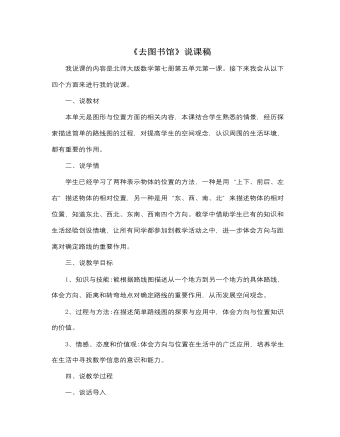
北师大版小学数学四年级上册《去图书馆》说课稿
一、说教材本单元是图形与位置方面的相关内容,本课结合学生熟悉的情景,经历探索描述简单的路线图的过程,对提高学生的空间观念,认识周围的生活环境,都有重要的作用。二、说学情学生已经学习了两种表示物体的位置的方法,一种是用“上下、前后、左右”描述物体的相对位置,另一种是用“东、西、南、北”来描述物体的相对位置,知道东北、西北、东南、西南四个方向。教学中借助学生已有的知识和生活经验创设情境,让所有同学都参加到教学活动之中,进一步体会方向与距离对确定路线的重要作用。三、说教学目标1、知识与技能:能根据路线图描述从一个地方到另一个地方的具体路线,体会方向、距离和转弯地点对确定路线的重要作用,从而发展空间观念。2、过程与方法:在描述简单路线图的探索与应用中,体会方向与位置知识的价值。3、情感、态度和价值观:体会方向与位置在生活中的广泛应用,培养学生在生活中寻找数学信息的意识和能力。
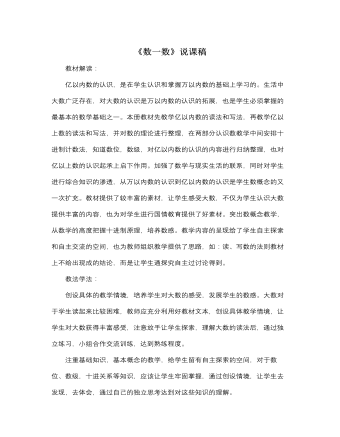
北师大版小学数学四年级上册《数一数》说课稿
亿以内数的认识,是在学生认识和掌握万以内数的基础上学习的。生活中大数广泛存在,对大数的认识是万以内数的认识的拓展,也是学生必须掌握的最基本的数学基础之一。本册教材先教学亿以内数的读法和写法,再教学亿以上数的读法和写法,并对数的理论进行整理,在两部分认识数教学中间安排十进制计数法,知道数位,数级,对亿以内数的认识的内容进行归纳整理,也对亿以上数的认识起承上启下作用。加强了数学与现实生活的联系,同时对学生进行综合知识的渗透,从万以内数的认识到亿以内数的认识是学生数概念的又一次扩充。教材提供了较丰富的素材,让学生感受大数,不仅为学生认识大数提供丰富的内容,也为对学生进行国情教育提供了好素材。突出数概念教学,从数学的高度把握十进制原理,培养数感。教学内容的呈现给了学生自主探索和自主交流的空间,也为教师组织教学提供了思路,如:读、写数的法则教材上不给出现成的结论,而是让学生通探究自主过讨论得到。
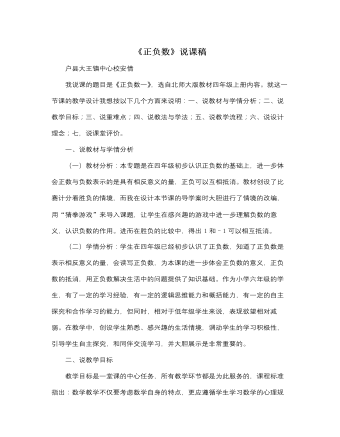
北师大版小学数学四年级上册《正负数》说课稿
二、说教学目标教学目标是一堂课的中心任务,所有教学环节都是为此服务的,课程标准指出:数学教学不仅要考虑数学自身的特点,更应遵循学生学习数学的心理规律??使学生获得对数学理解的同时,在思维能力、情感态度与价值观等方面都得到进步和发展。根据这一要求和本节教学内容,并结合学生的实际情况,本节课我确定如下学习目标:1、知识与技能在熟悉的生活情景中,进一步体会负数的意义;会用负数表示一些日常生活中的问题,知道正负可以相互抵消。2、过程与方法本节课以小组合作学习为主,让学生利用导学案自学,再对学、群学,最后在班里进行展示。整节课都是学生自主学习,积极探索的一个过程。3、情感、态度与价值观经历独学、交流、合作、展示等一系列活动,通过生生、师生互动获得良好的情感体验,同时让学生感受到了数学在生活中的应用。依据这样的教学目标,再结合学生的年龄特点,我运用了浅显易懂的儿童语言制定了导学案上的学习目标。
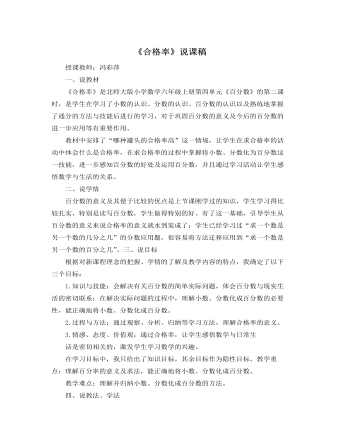
北师大版小学数学六年级上册《合格率》说课稿
四、说教法、学法我在教学中主要采用的教学方法是先学后教中的“两学两教”。辅之以多媒体教学手段(主要通过微课视频的观看学习)。本课学生的学习方法主要有:自主发现法、合作交流法、自学尝试法等。1.学生在自主探究解答例题,求两种品牌罐头的合格率时,主要采用自学尝试法,根据知识的迁移,学生能够正确求出产品合格率。2.在总结小数、分数化成百分数的方法时,学生主要采用自主发现,合作交流的方法。首先让学生观察例题板书,想一想怎样把小数、分数化成百分数,采用了“兵教兵”的方法,达到了人人参与的目的。当然,由于学生所处的文化环境,家庭背景和自身思维方式的不同,不同的学生所采用的方法也不尽相同,作为教师要尊重学生的选择,允许学生用自己喜欢的方式学习数学。五、说教学过程
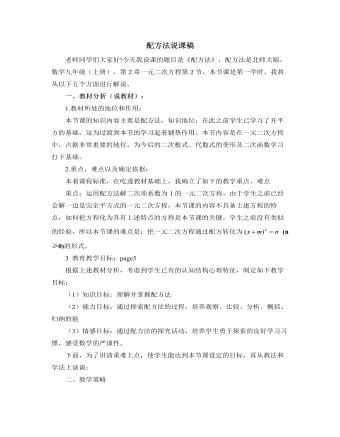
北师大版初中数学九年级上册配方法说课稿
用你的语言描述一下配方法解一元二次方程的基本步骤和需注意的问题。 教师引导学生进行反思、归纳配方法解一元二次方程的基本思路、步骤及注意事项。巩固对课堂知识的理解和掌握,同时进一步体会解一元二次方程时降次的基本策略和转化的思想。 六、布置作业分层布置作业,既巩固本节主要内容,又有让学有余力的学生有思考和提升的空间。思考题为后面深入研究配方法,完善对配方法的认识做准备。 同时让学生感受到数学学习在实际生活中的作用,感受数学的美。五、板书设计我将板书分成了两部分,重点突出这节课用配方法解一元二次方程的步骤,在配以适当的练习,简单明了,重点突出。六、教学评价与反思本节课我根据学生的特点采用合作交流探究式学西方法教学,让学生动起来,感受数学学习的乐趣。让学生更加爱学数学。
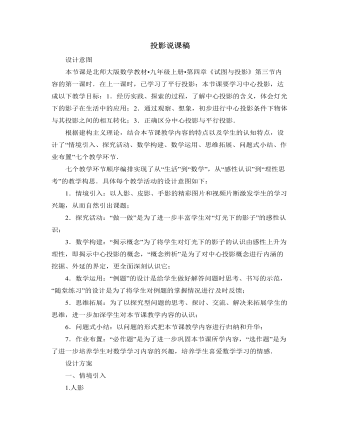
北师大版初中数学九年级上册投影说课稿
1.多媒体的合理应用,可极大的激发学生的学习兴趣,提高教学效果.在本节课的“情境引入”这一教学环节中,用媒体展示的人影、皮影、手影的精彩图片,用媒体播放的皮影戏、手影戏视频片断给学生以视觉冲击,产生了视觉和心理的震撼,这样在课堂“第一时间”抓住了学生的注意力、极大的激发了学生的学习热情,将十分有利于后面教学活动的开展,提高课堂教学效果.2.附有挑战性的“问题(或活动)”、层层深入的“问题串”可激发学生的探索欲望,培养创新精神,拓展思维能力.在本节课“探究活动”这一教学环节中的“做一做”设计的4个活动,由简单的“模仿”到“创作设计、观察思考”循序渐进、挑战性逐渐增大,不断激发学生的探索欲望,引人入胜,培养创新精神,拓展能力.再如,在本节课“数学运用”这一教学环节中的“例2”设计的2个问题层层深入,现实情境味很浓,学生做起来饶有兴趣.
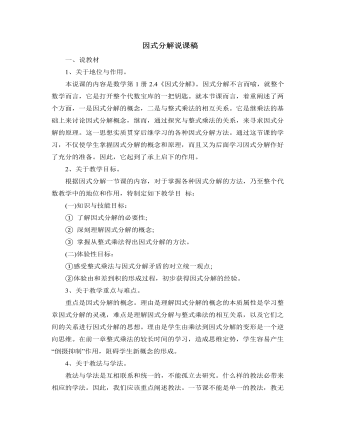
北师大版初中数学九年级上册因式分解说课稿
第三环节。尝试练习,信息反馈。让学生尝试练习:课本p152第3题,并引导中下学生看p152例题,教师及时点拨讲评。△教师安排这一过程,完全放手让学生自主进行,充分暴露学生的思维过程,展现学生生动活泼、主动求知和富有的个性,使学生真正成为学习的主体,使因式分解与整式的乘法的关系得到正强化。第四环节。小结阶段。这是最后的一个环节,教师出示“想一想”:下列式子从左边到右边是因式分解吗,为什么?学生展开讨论,得到下列结论:A.左边是乘法,而右边是差,不是积;B.左右两边都不是整式;C.从右边到左边是利用了因式分解的变形方法进行分解。由此可知,上式不是因式分解。进而,教师呈现因式分解定义。△教师安排这一过程意图是:学生一般到临近下课,大脑处于疲劳状态,注意力开始分散。
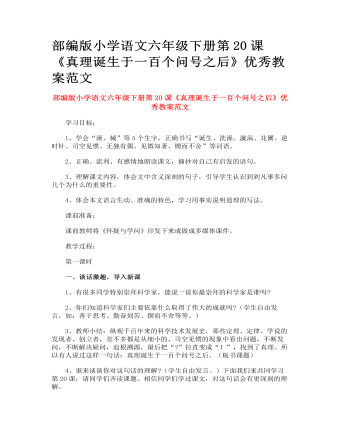
部编版小学语文六年级下册第20课《真理诞生于一百个问号之后》优秀教案范文
1、认真读课文,边读边想课文每个自然段都写了什么,给课文划分段落。2、学生交流段落划分,说明分段理由。3、教师对照板书进行小结:这篇课文思路特别明晰,作者开门见山提出自己的观点,明确指出“真理诞生于一百个问号之后”这句话本身就是“真理”,然后概括地指出在千百年来的科学技术发展史上,那些定理、定律、学说都是在发现者、创造者解答了“一百个问号之后”才获得的,由此引出科学发展史上的三个有代表性的确凿事例,之后对三个典型事例作结,强调这三个事例“都是很平常的事情”,却从中发现了真理,最后指出科学发现的“偶然机遇”只能给有准备的人,而不会给任何一个懒汉。

部编版小学语文四年级下册第25课《两个铁球同时着地》优秀教案范文
1、齐读第三自然段。思考:亚里士多德讲过什么话?伽利略对这话是怎么看的?(亚里士多德说过:“两个铁球,一个10磅重,一个1磅重,同时从高处落下来,10磅重的一定先着地,速度是1磅重的10倍。”伽利略对这话产生了怀疑)2、伽利略为什么怀疑亚里士多德说的话?他是怎么想的?(“他想:如果这句话是正确的,……这怎么解释呢?”)3、伽利略的分析,是把亚里士多德的话当作两种假设,推出两个结论。这两个结论是什么?(①把一个10磅重,一个1磅重的两个铁球拴在一起,如果仍然看作是两个球,落下的速度应当比原来10磅重的铁球慢。②如果看做是一个整体,落下的速度,应当比原来10磅重的铁球快)4.这两个结果一样吗?是什么样的结果?(不—样,是相互矛盾的)5.根据同一句话,会推出两个相互矛盾的结果,所以伽利略认为这句话是靠不住的,值得怀疑。6,他打算怎么做?(用试验来证明不同重量铁球落地的情况)

新人教版高中英语必修2Unit 1 Cultural Heritage-Discovering Useful Structure教案二
This theme of the part is “ Describe people or things in greater detail”. Students have learned the grammar(restrictive relative clauses) in Book 1, and further review and consolidate its structure “prep+relative pronouns(which/whom)” and the relative adverbs(when, where and why), besides students should understand its form, meaning and functions. In this section, students should be able to express the grammar correctly in daily communication and in the writing. 1. Review the basic usages of relative pronouns and adverbs of attributive clauses . 2. Learn to use some special cases about restrictive relative clauses.3. Learn to write sentences with restrictive relative clauses flexibly according to the context.1. Review the basic usages of relative pronouns and adverbs of attributive clauses .2. Learn to use some special cases about restrictive relative clauses.3. Learn tow rite sentences with restrictive relative clauses flexibly according to the context.Step 1. Observe the following sentences, and mark the relative pronouns and the adverbs. 1. After listening to the scientists who had studied the problems, and citizens who lived near the dam, the government turned to the United Nations for help.2. Temples and other cultural sites were taken down piece by piece, and then moved and put back together again in a place where they were safe from the water.Step 2 PracticePlease complete these sentences with relative pronouns and relative adverbs and answer the following questions.Questions: 1. What is the head noun ?2. What relative words should be used ?3. What elements do they act in these sentences ?

新人教版高中英语必修2Unit 2 Wildlife Protection-Reading for Writing教案二
This lesson aims at making a poster about protecting wildlife after reading some posters. During reading students are guided to understand the content and try to summarize the posters with one sentence. Then students are guided to try to make a poster about protecting wildlife.1. Read the two posters and try to understand the summary sentences.2. Look at the two posters and try to understand what emotions they express.3. Try to summarize the features of posters4. Try to make a poster about wildlife.1. Look at the two posters and try to understand what emotions they express.2. Try to summarize the features of posters3. Try to make a poster about wildlife.Step 1 Lead inLook at the the posters on the textbook and ask:Which emotions do the posters communicate ?Step 2 Read the poster and answer the questions.1. What do you think of the animals in the poster on the left ?I think it is frightening and ugly.2. Why do we should protect the ugly animals ?All species--the good, the bad, and the ugly-- should be treated equally.The world needs all kinds--without variety, our planet cannot survive.3. Why are billions of trees being cut down every year ?To make paper for humans.4. What result will be lead to after the trees are cut down ?A lost of animal homes are being destroyed./The habitat of wildlife is being destroyed.Step 3 Find the feature of posters1. What does each poster use to stir up emotions ?On the left, it makes us a little frightened and it looks a little ugly, but it can activate our curiosity--What is it? And What is wrong with it?On the right, it makes us feel a little sad and want to protect them.

新人教版高中英语必修2Unit 2 Wildlife Protection-Discovering Useful Structure教案二
2.表示现阶段正在进行的被动动作(该动作在说话的瞬间未必正在进行)。Many interesting experiments are being carried out these days.(说话时,并不一定正在进行)3.表示一种经常性的被动行为,常和always,constantly 等表示频度的副词连用,这种用法常常带有赞扬或厌恶的感情色彩。He is always being praised by the leader.4.表示按计划或安排主语将要承受谓语动词所表示的动作(仅限于少数及物动词)。A party is being held tonight.Step 4 Special cases1.像take care of, look after, talk about, think of等动词与介词构成的短语用于现在进行时的被动语态时, 其中的介词不可省略。The ways to stop illegally hunting are being talked about. 2.可与部分情态动词连用,表示对正在发生的事情的推测。She may be being punished by her mother.3.有时可表示按计划或安排将要进行的一个被动动作。A celebration is being held this weekend for his success.4.某些表示“状态、心理活动、存在”等的动词,如have,want,need,love,一般不用现在进行时的被动语态,而常用一般现在时的被动语态。With the population increasing,more land is needed.5.“be+under/in+n.”可表示现在进行时的被动意义。My computer is under repair.=My computer is being repaired.

新人教版高中英语必修2Unit 3 The Internet-Discovering Useful Structure教案二
This teaching period mainly deals with grammar “The Present Perfect Passive Voice.” To begin with, teachers should lead students to revise what they have learned about the Present Perfect Passive Voice. And then, teachers move on to stress more special cases concerning this grammar。This period carries considerable significance to the cultivation of students’ writing competence and lays a solid foundation for the basic appreciation of language beauty. The teacher is expected to enable students to master this period thoroughly and consolidate the knowledge by doing some exercises. 1. Guide students to review the basic usages of the Present Perfect Passive Voice2. Lead students to learn to use some special cases concerning the Present Perfect Passive Voice flexibly.2. Enable students to use the basic phrases structures flexibly.3. Strengthen students’ great interest in grammar learning.1. Help students to appreciate the function of the Present Perfect Passive Voice in a sentence2. Instruct students to write essays using the proper the Present Perfect Passive Voice.观察下列句子特点,总结共同点。1.(教材P28)Much has been written about the wonders of the World Wide Web.2.(教材P28)But the Internet has done much more for people than simply make life more convenient.3.(教材P28)Many people have been helped by the club.4.(教材P28)She no longer feels lonely, and her company has become quite successful.5.(教材P32)Today I thought I’d blog about a question that has been asked many times—how do you stay safe online and avoid bad experiences on the Internet?

新人教版高中英语必修2Unit 3 The Internet-Listening &Speaking&Talking教案二
From the pictures in the text and the title--- choose the best app, we can know that this part is about how to save money by using apps.Step 2 While-listening1. Laura and Xiao Bo are talking about apps. Listen to their conversation and find out what apps they want.Xiao Bo is looking for a(n) exercise app to help him get in shape.Laura would like an app for getting rich and another that will make her grades better.2. Listen again. Are the sentences true T or false F?1). Both of Xiao Bo's apps keep track of the steps he takes._____2). Xiao Bo's second app can help him make a fitness plan._____3). Laura needs an app that will help her get discounts.______4). Laura needs an app that will add money to her bank account._______F T F T3. Listen once more and tick the sentence you hear. Underline the words used to express predictions, guesses, and beliefs.Predictions, Guesses, and Beliefs________It might help me walk more.________My guess is that it wouldn't work.________I imagine this app would help me get fit faster________I suppose that would be good.________I guess you could save a little with this app.________I suppose there would be some problems, too.________I believe this app could help me get thinner.

新人教版高中英语必修2Unit 3 The Internet-Reading and Thinking教案二
Q5:What's Jan's next goal?Her next goal is to start a charity website to raise money for children in poor countries.Q6:What can we learn from her experiences?We learn that when we go through tough times, we can find help and support from other people online. We learn that we can feel less lonelyStep 5: While reading---rethinkingQ1: What is Jan’s attitude to the Internet ?Thankful/Grateful, because it has changed her and her life.Q2: What writing skills is used in the article ?Examples(Jan’s example, the 59-year-old man’s and the 61-year-old woman’s example)Q3: Can you get the main idea of the article ?The Internet has changed Jan’s life/Jan’s life has been changed by the Internet.Step 6 Post reading---Retell the storyMuch has been written about the wonders of the World Wide Web. There are countless articles (1)telling(tell) us how the Internet has made our lives more convenient. But the Internet has done a lot (2)more(much) for people than simply make life more convenient. People’s lives (3) have been changed(change) by online communities and social networks so far. Take Jan for example, who developed a serious illness that made her (4)stuck(stick) at home with only her computer to keep (5)her(she) company. She joined an online group (6)where she could share problems, support and advice with others. She considered the ability to remove the distance between people as one of the greatest (7)benefits(benefit). She was so inspired (8)that she started an IT club in which many people have been helped. She has started to learn more about how to use the Internet to make society better. Her next goal is to start a charity website to raise money (9)for children in poor countries. Jan’s life has been (10)greatly(great) improved by the Internet.

新人教版高中英语必修2Unit 3 The Internet-Reading for Writing教案二
8. However, the more polite you are, the less likely it is you will be attacked. 然而, 你越有礼貌, 你被攻击的可能性就越小。 Step 8 Writing---the articleHow to stay safe in the online chat roomToday I thought I’d blog about a question that has been asked many times--- how do you stay safe online and avoid bad experiences in the online chat room ? I’m not an expert, but many years as a blogger have taught me a thing or two.First of all, there’s the golden rule of the Internet: keep out of what makes you uneasy. Don’t post comments or click on anything. Second, protect your privacy. Don’t give out too much private information like your address, phone numbers, the ID numbers, etc. Third, be polite. If you are polite to others on the Internet, you won’t be attacked in normal situation. Finally, don’t believe in others easily and never meet someone you met online alone. It is very dangerous.Have you had any bad experiences online, or do you have some good advice for staying safe? Post your comments below!Step 9 Pair workExchange drafts with a partner. Use this checklist to help your partner revise his/her draft.1. Does the writer tell the reader what he/she know about the topic ?2. Are the tips and suggestions well organised ?3. Has the writer defined the new words ?4. Does the author include examples, comparison, or explanations ?5. Does the writer end by asking readers to leave comments and/or suggestions ?6. Can you find any grammar or spelling mistakes.Step 6 HomeworkPut up your revised draft in the classroom or read it to your class.

新人教版高中英语必修2Unit 4 History and Traditions-Discovering Useful Structure教案二
This teaching period mainly deals with grammar: The past participle is used as attributive and objective complement.1. Guide students to review the basic usages of the past participle used as attributive and objective complement.2. Lead students to learn to use some special cases concerning the past participle used as attributive and objective complement flexibly.3. Strengthen students’ great interest in grammar learning.1. Help students to appreciate the function of the past participle used as attributive and objective complement.2. Instruct students to write essays using the past participle used as attributive and objective complement.Step1:温故而知新。Analyze the underlined phrases and then sum up the common usages of the past participles.1.(教材P41)They had castles built(build) all around England, and made changes to the legal system.2.(教材P42)They use the same flag, known(know) as the Union Jack,...3.(教材P42)Judy and I had our car parked(park) in an underground car park near Trafalgar Square, where we could get our car battery charged(charge).Common points: f the past participle used as attributive and objective complement.Step 2:过去分词作定语时的意义1.及物动词的过去分词作定语,在语态上表示被动;在时间上,常表示动作已经发生或完成,有时也不表示时间性。Our teacher watched us doing the experiment and gave us a satisfied smile at last.我们的老师看着我们做实验,最后给了我们一个满意的微笑。The plan put forward at the meeting will be carried out soon.会上提出的计划将很快被执行。2.不及物动词的过去分词作定语,它不表示被动意义,只强调动作完成。Many little kids like gathering fallen leaves in the yard.